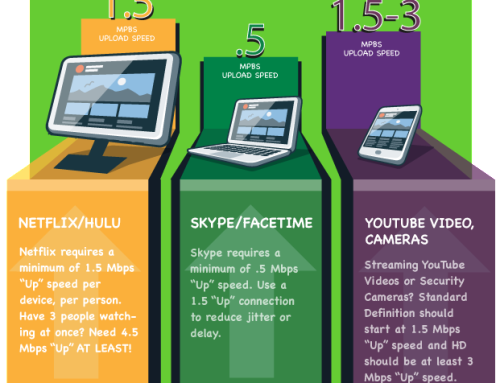Why is Upload Speed Important?
All ISPs (Internet Service Providers) tout their “download” speed . . . but very few ISPs even mention their “upload” speed.
Should you conclude then, that the “up” or “sending” speed is not very important?
An important part of all communication is acknowledgement that the message was received. In all conversations, knowing that the message was received is as important as sending the message. Humans look for some small voice or body language acknowledgement that what we are trying to communicate is being received. Otherwise, the same message is just re-sent again and again (we keep talking), until an acknowledgement is understood or we just give up. The more sending and receiving occurs in a balanced fashion, the more rewarding, or complete, the conversation is considered. The Internet works exactly the same way.
We are all receiving information from the Internet, but how does that information, or content, get sent to us? A small amount of information is requested, then sent, and it waits on an acknowledgement. If confirmation of that information is received, then a little more, and a little larger amount, of information is sent. This negotiation continues with larger amounts of information until there is some kind of error, interference, or other limitation. This is how the Internet is set up, and it works very well. No matter what kind of information is being received, there has to be enough “sending” to keep it coming. If you are not acknowledging enough, the Internet Protocol slows down and repeats the information. It is not a bug; it is a built-in feature of the Internet to enhance reliability. (In fact, this very feature is what network technicians use to “certify” your Internet connection speed. The “up” speed is monitored or checked, and the “down” speed is adjusted to the optimum to match. Now you know why your connection is so slow, no matter what “down” speed you were quoted.)
Satellite-based Internet suffers from the delay, (or lag, or latency), of long distance acknowledgements. It is far superior to dial-up, and it is very good at streaming a continuous amount of data, as long as it gets some idea that it is being received. It is not very good at interactive connections, which is why most web sites and gaming devices don’t seem to work very well. Internet based music streaming does not work very well. Satellite-based Internet can be had almost anywhere, it just should not be your first choice if you have a choice.
Telephone Company copper wire based DSL Internet connections were a vast improvement over dial-up connections. It uses the same copper wire that have been used for the last 100 years, it just uses different kinds of equipment on each end, in this case, digital signals instead of audio signals. It worked great, but it is limited in the speeds and distances that it can reach. The Digital Subscriber Line (DSL), came into the market just when we were all moving from a single desktop PC to multiple desktop PCs, then Laptops, then Notebooks, now iPads and Smartphones. DSL was great for a single device but is not as efficient if you have multiple devices in your home or office all using the same network, because they all need their piece of the “up” connection. DSL was not designed for today’s Internet.
There are symmetrical, (same speed both ways), connections which are more expensive than the normal asymmetrical (more download and less “upload” speed) connections. These connections are normally what server computers use to send Internet content like email, video, and voice to us.
The Internet is a two-way communication process, and is much more interactive and participatory than it has ever been. That means that we are “sending” more and more “up” to the Internet, or the “Cloud,” than ever before.
In fact, things as simple as email or word processing programs are becoming more and more “Cloud” based. This requires more balanced connections if we want to use them efficiently.We have more devices than ever before, and they all need their piece of the connection. The more devices you have, the more download and upload speed you need.
Why is this important to you? To give you an idea, we have listed a few mainstream applications and their recommended “up” speed for one device:
So if you are dissatisfied with your Internet results because it runs slow, or lags, even though you might have a 6-15 Mbps download plan, it is probably because your “up” speed is low. GoBrolly® offers several plans with unsurpassed “up” speeds at an affordable price.


